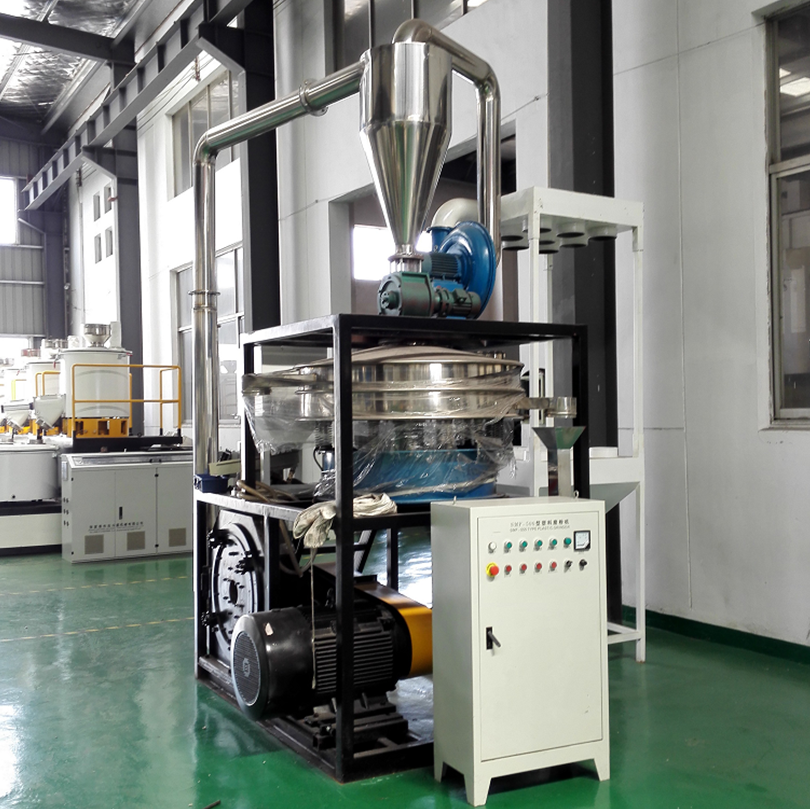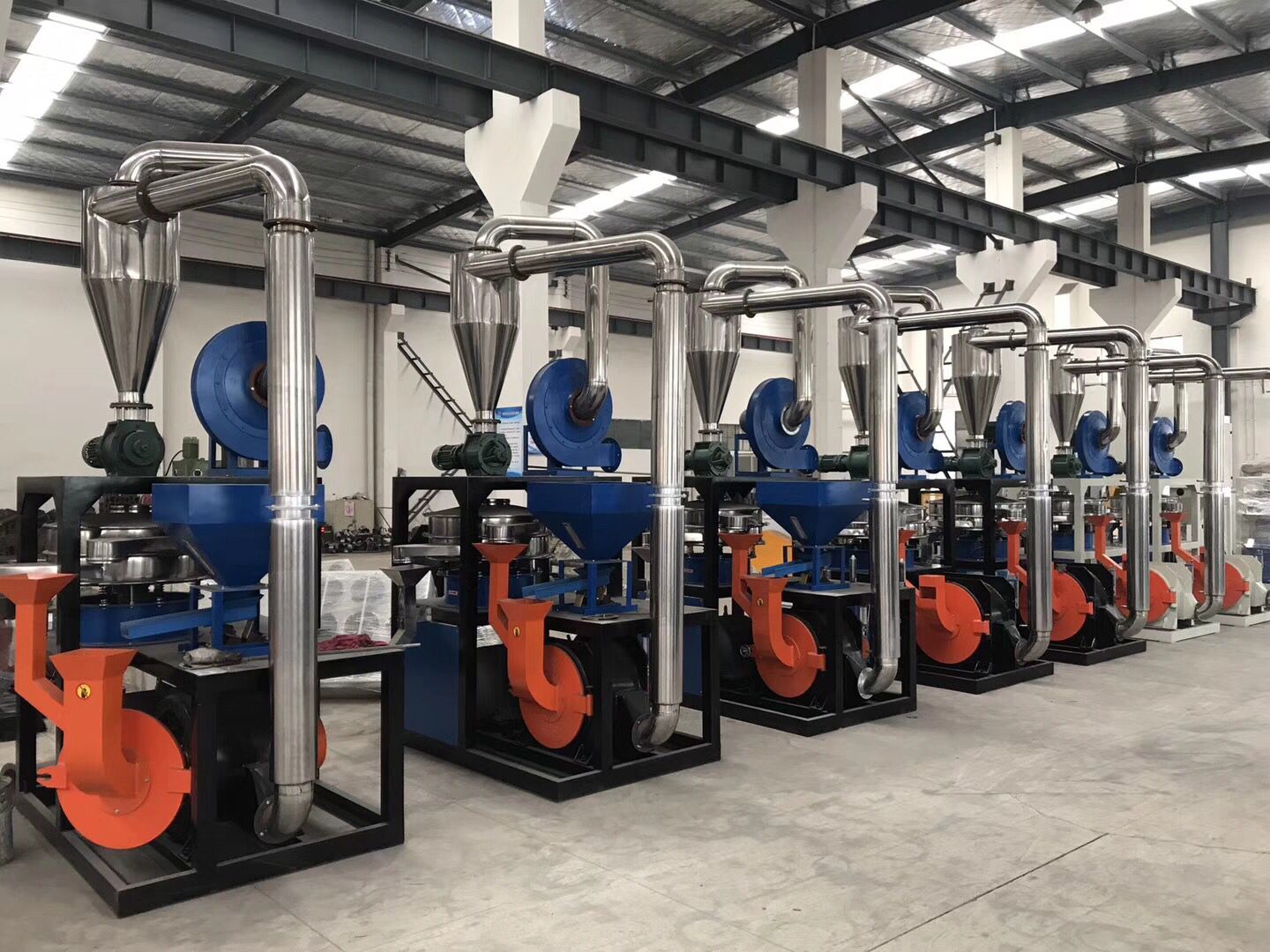Views: 0 Author: Site Editor Publish Time: 2025-10-01 Origin: Site











In the modern plastic industry, achieving high efficiency, consistent quality, and cost-effectiveness requires more than just powerful extruders or molding machines. Behind every successful production line lies a network of auxiliary machines—supportive devices that ensure the main equipment runs smoothly and reliably. These include loaders, dryers, chillers, mixers, crushers, and, notably, pulverizers.
Auxiliary machines act as the backbone of plastics manufacturing by handling essential but often overlooked processes such as material preparation, temperature control, and waste recycling. Their role is not secondary but complementary, ensuring that the final product meets industry standards and customer expectations.
Among these machines, the pulverizer is particularly important. It provides fine size reduction of plastics, creating powders suitable for further extrusion, molding, or compounding. Without pulverizers, recycling loops would break down, production lines would struggle with inconsistent feedstock, and costs would rise sharply due to wasted materials.
An auxiliary machine is defined as equipment that supports primary production processes. In plastics, extruders and injection molding machines do the core shaping work, but auxiliary machines manage all the preparatory and finishing tasks. They dry moisture-sensitive materials, grind oversized particles, feed raw materials consistently, and remove impurities.
Without these supportive devices, manufacturers would face downtime, poor product quality, and reduced efficiency. This is why auxiliary machines are considered equally critical as the main production units.
A pulverizer is an auxiliary machine that reduces plastic waste, scraps, or raw materials into fine powders. This is achieved through high-speed mechanical action using discs, blades, or hammering systems. The powders produced by pulverizers are essential because they can be directly used in processes like extrusion, compounding, and molding without additional pre-treatment.
The precision of a pulverizer allows manufacturers to create consistent particle sizes, which translates into uniform product quality. Unlike rough crushers that produce flakes or chunks, pulverizers generate fine powders that integrate seamlessly into production lines.
Feature |
Crusher |
Pulverizer |
Output Size |
Large flakes or irregular chips |
Fine powder or micron-sized particles |
Application |
First stage of recycling |
Final preparation for extrusion or molding |
Function |
Break down bulky waste |
Provide precision material refinement |
Placement in Line |
Early stage |
Mid-to-late stage |
This distinction explains why pulverizers are regarded as indispensable auxiliary machines in modern plastic production.
Pulverizers provide a range of functions that directly support both primary machines and other auxiliary machines.
The primary purpose of a pulverizer is to reduce plastics into a manageable size. For example, rigid PVC offcuts can be ground into powders that are later remelted into pipes or profiles. PE film waste can be pulverized into uniform granules, making it easier to feed into an extruder. By converting waste into usable feedstock, pulverizers close the loop in material utilization.
One of the main challenges in plastic manufacturing is achieving uniform particle size. Inconsistent particle distribution can lead to poor melt flow, product defects, and increased machine wear. Pulverizers, as precision auxiliary machines, solve this by producing evenly sized powders that enhance downstream processing efficiency.
In recycling lines, pulverizers transform post-consumer plastics into fine powders ready for reuse. This not only reduces environmental impact but also enables companies to lower raw material costs. For example, recycled PVC powder can be blended with virgin material to maintain product performance while cutting expenses.
Pulverizers enable manufacturers to reuse scraps and off-spec products, drastically reducing waste disposal costs. By turning unusable waste into valuable feedstock, they improve overall profitability and support sustainable practices.
Pulverizers operate continuously, ensuring a steady supply of fine powders. This uninterrupted material preparation allows extruders and molding machines to work without bottlenecks, raising overall output capacity.
Compared to using raw virgin materials, reusing pulverized powders reduces dependency on expensive inputs. Moreover, modern pulverizers are designed with energy-efficient motors and optimized cutting systems, which lower electricity consumption. This makes them one of the most cost-effective auxiliary machines in production lines.
The particle uniformity achieved by pulverizers results in better melt homogeneity and smoother final products. In extrusion, for instance, consistent powder improves pipe wall thickness and surface finish. In injection molding, fine powders reduce the risk of air bubbles and weak spots.
Pulverizers rarely work alone. They complement dryers that remove moisture, loaders that ensure continuous feeding, and mixers that blend powders with additives. Together, these auxiliary machines create a seamless workflow where every stage supports the next, maximizing production stability.
A well-designed recycling line showcases how pulverizers integrate with other auxiliary machines:
Crusher breaks large plastic waste into flakes.
Washing System removes contaminants like dirt, ink, or adhesives.
Pulverizer reduces flakes into fine powder.
Mixer/Dryer prepares the powder with additives and removes residual moisture.
Extruder or Granulator transforms the material into pellets or end products.
In a pipe production line, pulverizers prepare the base PVC powder that feeds directly into extruders. Auxiliary machines such as automatic feeders and hopper dryers ensure consistent material flow, while cooling systems finalize the pipe. The pulverizer’s role is central because it guarantees the raw material is fine, dry, and uniform enough for high-quality output.
Through such integration, pulverizers bridge the gap between raw material preparation and final product formation, confirming their importance as auxiliary machines.

Like all auxiliary machines, pulverizers require diligent care to operate effectively over long periods.
Blade Wear: Worn blades lead to inconsistent powder size.
Overheating: Excess heat may degrade material quality and damage machine parts.
Motor Overload: Caused by irregular feeding or processing material beyond machine capacity.
Regular Inspection: Check blades, bearings, and motor performance weekly.
Temperature Control: Use proper cooling systems to avoid overheating.
Consistent Feeding: Avoid overloading by ensuring material is fed evenly.
Preventive Maintenance: Schedule downtime for cleaning, lubrication, and part replacement.
Use original or high-quality replacement components.
Train staff to handle the pulverizer correctly, avoiding misuse.
Implement IoT-based monitoring tools for predictive maintenance.
By following these practices, manufacturers can extend the lifespan of pulverizers and reduce unexpected downtime, ensuring continuous production.
Next-generation pulverizers are being developed with smart sensors and PLC systems. These allow operators to track parameters such as particle size distribution, motor load, and blade condition in real time. Automated adjustments ensure consistency without manual intervention.
Environmental concerns are pushing manufacturers to adopt eco-friendly designs. Pulverizers now feature noise reduction, dust collection systems, and motors engineered for low energy consumption. These innovations align with sustainability goals and regulatory standards.
With the rise of Industry 4.0, pulverizers are increasingly integrated into digital ecosystems. IoT-enabled auxiliary machines provide continuous performance data, which can be analyzed to predict failures before they occur. This reduces maintenance costs and improves reliability.
Pulverizers directly support the circular economy by enabling more efficient recycling. By converting post-consumer plastics into reusable powders, they reduce dependence on virgin materials and lower the environmental footprint of production. This trend is expected to grow as governments and industries worldwide emphasize sustainability.
Pulverizers stand out as one of the most essential auxiliary machines in the plastic industry. By transforming both virgin and recycled plastics into fine, uniform powders, they ensure smooth downstream processing, higher efficiency, and consistent product quality. Their impact goes beyond productivity—pulverizers also help manufacturers cut material costs and meet sustainability goals through effective recycling.
When integrated with other auxiliary machines such as crushers, dryers, mixers, and loaders, pulverizers become the backbone of modern, high-performance production lines. With advancements in automation and energy-saving technologies, they are evolving into smarter and greener solutions that no forward-looking manufacturer can ignore.
For companies aiming to stay competitive, selecting the right pulverizer is more than just a purchase—it is a strategic investment in long-term success. To explore reliable solutions, Zhangjiagang Lvima Technology Co., Ltd. is a trusted partner specializing in advanced auxiliary machines, including high-performance pulverizers tailored to diverse production needs. Their expertise and commitment to quality make them an excellent resource for businesses seeking efficiency and innovation.
